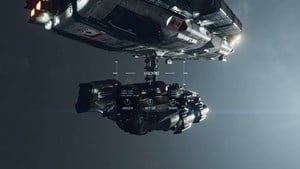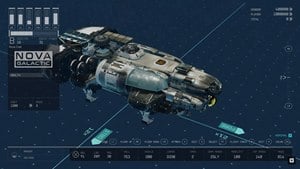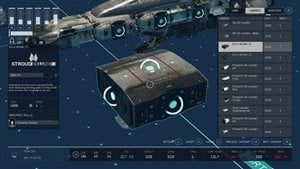Spaceships are a key mode of transportation in Starfield, allowing players to travel from planet to planet. Players will also be able to engage in combat with enemy spaceships while flying in their own spaceship. There will be a mechanic allowing you to dock and board onto other spaceships/structures in outer space.
After docking, you'll be able to get up and board the other ship or star station, whether it be an ally or an enemy ship. From there possible actions involve boarding and disabling enemy ships, stealing ships, completing Missions and smuggling.
Spaceships will be completely customizable and will feature an intricate assembly system. There will be many Ship Modules to choose from, including different engines, landers, and shields, all of which may have different manufacturers. You can find all the relevant information and updates on Spaceships on this page.
How does Ship Customization work in Starfield?
When you visit any space port, you will come across a ship technician who acts as a trustworthy merchant. These technicians provide a range of services, including the opportunity to buy and sell various parts, handle repair payments, and even assist you in finding a crew for your ship. However, one of the most exciting aspects of visiting these technicians is the chance to modify and build your very own Starfield ships.
The process of ship construction in Starfield utilizes a modular system consisting of different sections and rooms. This clever system allows you to attach important elements to your ship, such as engines, cockpits, shields, weapons, and storage areas. These components are crucial as they grant you access to essential abilities and options that can greatly enhance your ship's performance. Each component has its own set of statistics, which means you must carefully balance them to ensure your ship functions optimally.
In Starfield, crafting and research mainly focus on developing personal weapons and general equipment. However, it's important to note that certain skills can also have an impact on your ship. For example, if you improve your Payloads skill, you can increase the cargo space of your vessel, allowing you to transport more goods. While ship building primarily revolves around purchasing parts from vendors, the components and modules available showcase various corporate logos. Each manufacturer has its own unique style and atmosphere, which means the choices you encounter may differ depending on the Starfield factions you interact with or the star systems you explore within the game. Different manufacturers are likely to have distinct characteristics, such as being fast but vulnerable, slow but strong, or possessing superior firepower.
The beauty of this ship building system lies in its flexibility, enabling you to create a wide range of vessels within the established rules and budgets. Whether you prefer sleek fighters, sturdy warships, or compact cargo carriers, the options are plentiful. If speed is your top priority, you can choose to sacrifice some combat capabilities by forgoing weapons or shields and instead focus on installing additional engines. This strategy allows you to rely on speed and agility to avoid confrontations when necessary. It's important to keep in mind that you also have the potential to remove certain components from your ship and sell them for monetary gain. However, it's crucial to ensure that you retain enough essential parts to facilitate a safe takeoff.
Despite the numerous possibilities, there is one limitation you should be aware of: certain components require a specific level of proficiency in the "Starship Design" skill to either acquire or effectively use them. Therefore, your progression in Starfield skills will directly impact your ship crafting capabilities. The more you improve your Starfield skills, the more advanced and sophisticated ships you'll be able to create.
Ship Power Allocation in Starfield
In the immersive world of Starfield, power allocation plays a vital role in shaping the capabilities of your spacecraft. This intriguing feature empowers you to effectively distribute the available power among the diverse ship systems at your disposal. With each system requiring a specific amount of energy, the allocation determines the precise amount that is assigned to each system. Visualized through a horizontal bar representing the overall energy production and six vertical indicators symbolizing the individual systems, this system grants you the freedom to finely tune your ship's functionality. During your exhilarating gameplay, you hold the reins to adjust these power allocation bars, allowing you to tailor your ship's performance according to your unique preferences and the demands of the situation at hand. By intelligently allocating more power to your formidable arsenal of weapons, encompassing powerful lasers (LAS), ballistic weapons (BAL), and devastating missiles (MSL), you can witness a notable surge in your damage output. However, this potency comes at a price, as you are compelled to divert power away from other crucial ship areas.
For instance, should you choose to reduce the power assigned to the engines (ENG), you will notice a decrease in your ship's speed, potentially impacting your ability to swiftly navigate the vast cosmic expanse. Similarly, diminishing the power allocated to the shields (SHD) will render your vessel more susceptible to the onslaught of enemy attacks, increasing the inherent risks of your interstellar endeavors. Furthermore, opting for a lower power supply for the grav drive (GRV) will inevitably elongate the time required for your ship to initiate a jump, presenting potential challenges when it comes to executing hasty escapes. As you embark on this thrilling spacefaring journey, the art of skillful power allocation emerges as a vital aspect of ship customization. By tactically fine-tuning the power distribution, you possess the opportunity to sculpt your ship's performance in alignment with your distinct playstyle and strategic objectives. However, it is crucial to weigh the trade-offs and ramifications that accompany the redirection of power from one system to another. Navigating this delicate equilibrium is the key to maximizing the potential of your spacecraft while effectively managing the limitations and consequences inherent to this dynamic power allocation system.
How to get a ship in Starfield?
Currently, acquiring ships has become quite accessible as you can obtain them by simply buying them from Ship Technicians stationed at the Space Ports. These technicians are available at every Spaceport, making it convenient for you to purchase, sell, or even modify your ships according to your preferences and needs. Whether you're inclined towards embarking on thrilling bounty hunting missions or seeking a vessel for transporting valuable cargo or even partaking in the not-so-legal activities of smuggling, you have the option to kickstart your spacefaring adventures with a nimble and swift fighter or opt for a more spacious and versatile Space Freighter. The choice is yours to make, and the Space Ports offer a range of possibilities to cater to your specific desires in the vast expanse of the galactic frontier.
Ship Stats in Starfield
In Starfield, the ship customization statistics encompass the fundamental elements of design, including the following key aspects:
- LAS
- BAL
- MSL
- Hull
- Shield
- Cargo
- Crew
- Jump Range
- Mobility
- Top Speed
- Mass
In Starfield, the health of your ship is represented by the Hull and Shield attributes, which act as visual indicators akin to health bars. They reflect the ship's resilience and capacity to endure damage. The ship's maneuverability and speed during flight are directly influenced by the Mobility and Top Speed characteristics. These attributes determine how agile and swift your ship can navigate through the vastness of space. The Cargo capacity of your vessel determines the amount of cargo, goods, and items you can effectively store onboard. Additionally, the Jump Range feature determines the maximum distance your ship can travel between different star systems. It is crucial to note that the weight of your cargo can impact the consumption of jump fuel, necessitating careful consideration of the cargo's weight and its effect on your ship's travel capabilities. Furthermore, Starfield introduces specific designations to represent different weapon and damage types. LAS denotes Laser weaponry, BAL represents Ballistic weapons, and MSL signifies Missiles. Each of these weapon types offers distinct approaches to combat and varying degrees of damage output.
Certain modules available in Starfield, such as cockpits and habitats, are equipped with Crew stats, indicating the maximum number of crew members they can accommodate. On the other hand, Mass is a significant factor associated with every module in the game. Adding new components to your ship increases its overall mass, which in turn affects both the Jump Range and Mobility attributes. As your ship's weight increases, it becomes more challenging to maneuver and fly efficiently. Consequently, there is a trade-off to consider between incorporating additional components and the resulting impact on your ship's weight and maneuverability. Thoughtful decision-making is required when engaging in ship design and customization to strike the right balance between desired features and practical limitations.
Starfield Spaceships
Ship Modules in Starfield are customizable parts of the player's Spaceship. Ship Modules will come in all shapes, sizes, and manufacturers, and players will be able to freely design the layout, color palette, and power of their spaceship. These parts will cost credits and resources to use, and some may even require the player to have specific Skills unlocked. You can find all the relevant information and updates on Ship Modules on this page.
Known Ship Modules include:
- Cockpit
- Cowling
- Docker
- Grav Drive
- Weapons
- Cargo Hold
- Bay
- Engines - May determine ship speed
- Fuel Tanks - May determine thruster capacity
- Landing Gears
- HAB (Habitation Modules) - May determine how many people you can fit in your crew
- Reactors
- Shield Generator
Fuel is an important part of flying a ship. From a Q&A video with Todd Howard, it has been revealed that Starfield's development team has changed how fuel works in-game. The previous iteration of fuel mechanics had it so that once players ran out of fuel, their ship came to a standstill. However, this felt too punishing from a player's perspective, and so it was changed so that fuel no longer runs out completely, and instead the amount of fuel available in the ship determines how far in space the player can travel at once.



